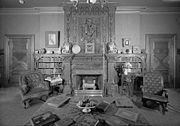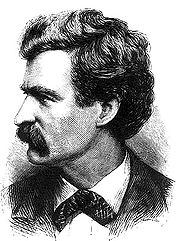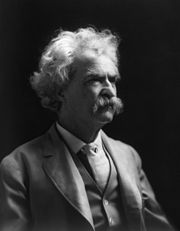
Mark Twain
About this schools Wikipedia selection
This selection is made for schools by a children's charity read more. Click here for more information on SOS Children.
| Samuel Langhorne Clemens | |
|---|---|
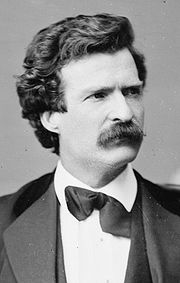 Mark Twain, detail of photo by Mathew Brady, February 7, 1871 |
|
| Pen name | Mark Twain |
| Occupation | Writer, lecturer |
| Nationality | American |
| Genres | Fiction, historical fiction, children's literature, non-fiction, travel literature, satire, essay, philosophical literature, social commentary, literary criticism |
| Notable work(s) | Adventures of Huckleberry Finn, The Adventures of Tom Sawyer |
|
Influences
|
|
|
Influenced
|
|
|
|
|
| Signature | |
Samuel Langhorne Clemens ( November 30 1835 – April 21 1910), better known by the pen name Mark Twain, was an American humorist, satirist, lecturer and writer. Twain is most noted for his novels Adventures of Huckleberry Finn, which has since been called the Great American Novel, and The Adventures of Tom Sawyer. He is also known for his quotations. During his lifetime, Twain became a friend to presidents, artists, industrialists and European royalty.
Twain enjoyed immense public popularity, and his keen wit and incisive satire earned him praise from both critics and peers. American author William Faulkner called Twain "the father of American literature."
Biography
Early life
Samuel Langhorne Clemens, "Mark Twain", was born in Florida, Missouri on November 30 1835 to a Tennessee country merchant, John Marshall Clemens ( August 11 1798 – March 24 1847), and Jane Lampton Clemens ( June 18 1803 – October 27 1890). He was the sixth of seven children. Only three of his siblings survived childhood: his brothers Orion ( July 17 1825 – December 11 1897) and Henry ( July 13 1838 – June 21 1858) and his sister Pamela ( September 19 1827 – August 31 1904). His sister Margaret ( May 31 1830 – August 17 1839) died when Twain was four years old, and his brother Benjamin ( June 8 1832 – May 12 1842) died three years later. Another brother, Pleasant (1828–1829), died at the age of six months. He was born two weeks after the closest approach to Earth of Halley's Comet (see 1835 comment).
When Twain was four, his family moved to Hannibal, a port town on the Mississippi River that would serve as the inspiration for the fictional town of St. Petersburg in The Adventures of Tom Sawyer and Adventures of Huckleberry Finn. At that time, Missouri was a slave state in the Union, and young Twain became familiar with the institution of slavery, a theme he later explored in his writing.
In March 1847, when Twain was 11, his father died of pneumonia. The following year, he became a printer's apprentice. In 1851, he began working as a typesetter and contributor of articles and humorous sketches for the Hannibal Journal, a newspaper owned by his brother, Orion. When he was 18, he left Hannibal and worked as a printer in New York City, Philadelphia, St. Louis and Cincinnati. He joined the union and educated himself in public libraries in the evenings, finding wider sources of information than he would have at a conventional school. At 22, Twain returned to Missouri. On a voyage to New Orleans down the Mississippi, the steamboat pilot, Horace E. Bixby, inspired Twain to likewise pursue a career as a steamboat pilot; it was a richly rewarding occupation with wages set at $250 per month, equivalent to $155,000 a year today.
Because the steamboats at the time were constructed of very dry flammable wood, no lamps were allowed, making night travel a precarious endeavor. A steamboat pilot needed a vast knowledge of the ever-changing river to be able to stop at any of the hundreds of ports and wood-lots along the river banks. Twain meticulously studied 2,000 miles (3,200 km) of the Mississippi for more than two years before he received his steamboat pilot license in 1859. While training, Samuel convinced his younger brother Henry to work with him. Henry was killed on June 21 1858, when the steamboat he was working on, the Pennsylvania, exploded. Twain had foreseen this death in a detailed dream a month earlier, which inspired his interest in parapsychology; he was an early member of the Society for Psychical Research. Twain was guilt-stricken over his brother's death and held himself responsible for the rest of his life. However, he continued to work on the river and served as a river pilot until the American Civil War broke out in 1861 and traffic along the Mississippi was curtailed.
Travels and family
Missouri was a slave state and considered by many to be part of the South, but it did not join the Confederacy. When the war began, Twain and his friends formed a Confederate militia (depicted in an 1885 short story, " The Private History of a Campaign That Failed"), which drilled for only two weeks before disbanding. Twain joined his brother, Orion, who had been appointed secretary to the territorial governor of Nevada, James W. Nye, and headed west.
Twain and his brother traveled for more than two weeks on a stagecoach across the Great Plains and the Rocky Mountains, visiting the Mormon community in Salt Lake City along the way. These experiences became the basis of the book Roughing It, and provided material for The Celebrated Jumping Frog of Calaveras County. Twain's journey ended in the silver-mining town of Virginia City, Nevada, where he became a miner. Twain failed as a miner and found work at a Virginia City newspaper, the Territorial Enterprise. On February 3 1863, he signed a humorous travel account "LETTER FROM CARSON - re: Joe Goodman; party at Gov. Johnson's; music" with "Mark Twain".
Twain then traveled to San Francisco, California, where he continued as a journalist and began lecturing. He met other writers such as Bret Harte, Artemus Ward and Dan DeQuille. An assignment in Hawaii became the basis for his first lectures. In 1867, a local newspaper funded a trip to the Mediterranean. During his tour of Europe and the Middle East, he wrote a popular collection of travel letters which were compiled as The Innocents Abroad in 1869.
Twain met Charles Langdon, who showed him a picture of his sister Olivia; Twain claimed to have fallen in love at first sight. They met in 1868, were engaged a year later, and married in February 1870 in Elmira, New York. She came from a "wealthy but liberal family", and through her he met abolitionists, "socialists, principled atheists and activists for women's rights and social equality", including Harriet Beecher Stowe, Frederick Douglass and the utopian socialist William Dean Howells.
The couple lived in Buffalo, New York from 1869 to 1871. Twain owned a stake in the Buffalo Express, and worked as an editor and writer. Their son Langdon died of diphtheria at 19 months.
In 1871, Twain moved his family to Hartford, Connecticut, where starting in 1873 he arranged the building of a dramatic house for them, which local admirers saved from demolition in 1927 and eventually turned into a museum focused on him. There Olivia gave birth to three daughters: Susy (1872-1896), Clara (1874-1962) and Jean (1880-1909). The couple's marriage lasted 34 years, until Olivia's death in 1904.
During his years in Hartford, Twain became friends with fellow author William Dean Howells.
Later life and death
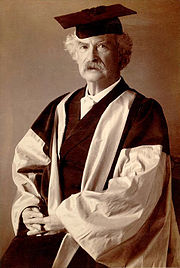
Twain made a second tour of Europe, described in the 1880 book A Tramp Abroad. His tour included a visit to London where, in the summer of 1900, he was the guest of newspaper proprietor Hugh Gilzean-Reid at Dollis Hill House. Twain wrote of Dollis Hill that he had "never seen any place that was so satisfactorily situated, with its noble trees and stretch of country, and everything that went to make life delightful, and all within a biscuit's throw of the metropolis of the world." He returned to America in 1900, having earned enough to pay off his debts.
In 1906, Twain began his autobiography in the North American Review. Oxford University awarded him a Doctorate in Letters a year later.
Twain outlived Jean and Susy. He passed through a period of deep depression, which began in 1896 when his favorite daughter Susy died of meningitis. Olivia's death in 1904 and Jean's death on December 24 1909 deepened his gloom.
In 1909, Twain is quoted as saying:
| “ | I came in with Halley's Comet in 1835. It is coming again next year, and I expect to go out with it. It will be the greatest disappointment of my life if I don't go out with Halley's Comet. The Almighty has said, no doubt: 'Now here are these two unaccountable freaks; they came in together, they must go out together.' | ” |
His prediction was accurate—Twain died of a heart attack on April 21 1910 in Redding, Connecticut, one day after the comet's closest approach to Earth (see Halley's Comet, 1835 entry).
In the New York Journal, in 1897, Twain said "The report of my death was an exaggeration."
Upon hearing of Twain's death, President William Howard Taft said:
| “ | Mark Twain gave pleasure—real intellectual enjoyment—to millions, and his works will continue to give such pleasure to millions yet to come... His humor was American, but he was nearly as much appreciated by Englishmen and people of other countries as by his own countrymen. He has made an enduring part of American literature. | ” |
Twain is buried in his wife's family plot in Elmira, New York.
Life as a writer
Career overview
Twain began his career writing light, humorous verse but evolved into a grim, almost profane chronicler of the vanities, hypocrisies and murderous acts of mankind. At mid-career, with Huckleberry Finn, he combined rich humor, sturdy narrative and social criticism. Twain was a master at rendering colloquial speech and helped to create and popularize a distinctive American literature built on American themes and language. Many of Twain's works have been suppressed at times for various reasons. Adventures of Huckleberry Finn has been repeatedly restricted in American high schools.
Unfortunately, a complete bibliography of his works is nearly impossible to compile because of the vast number of pieces wrtten by Twain (often in obscure newspapers) and his use of several different pennames. Additionally, many believe that a large portion of his speeches and lectures have been lost or simply were not written down; thus, the collection of Twain's works is an ongoing process. Researchers have rediscovered published material by Twain as recently as 1995.
Early journalism and travelogues
Twain's first important work, The Celebrated Jumping Frog of Calaveras County, was first published in the New York Saturday Press on November 18 1865. The only reason it was published there was because his story arrived too late to be included in a book Artemus Ward was compiling featuring sketches of the wild American West.
After this burst of popularity, Twain was commissioned by the Sacramento Union to write letters about his travel experiences for publication in the newspaper, his first of which was to ride the steamer Ajax in its maiden voyage to Hawaii, referred to at the time as the Sandwich Islands. These humorous letters proved the genesis to his work with the San Francisco Alta California newspaper, which designated him a traveling correspondent for a trip from San Francisco to New York City via the Panama isthmus. All the while Twain was writing letters meant for publishing back and forth, chronicling his experiences with his burlesque humor. On June 8 1867, Twain set sail on the pleasure cruiser Quaker City for five months. This trip resulted in The Innocents Abroad or The New Pilgrims' Progress.
| “ | This book is a record of a pleasure trip. If it were a record of a solemn scientific expedition it would have about it the gravity, that profundity, and that impressive incomprehensibility which are so proper to works of that kind, and withal so attractive. Yet not withstanding it is only a record of a picnic, it has a purpose, which is, to suggest to the reader how he would be likely to see Europe and the East if he looked at them with his own eyes instead of the eyes of those who traveled in those countries before him. I make small pretense of showing anyone how he ought to look at objects of interest beyond the sea – other books do that, and therefore, even if I were competent to do it, there is no need. | ” |
In 1872, Twain published a second piece of travel literature, Roughing It, as a semi-sequel to Innocents. Roughing It is a semi-autobiographical account of Twain's journey to Nevada and his subsequent life in the American West. The book lampoons American and Western society in the same way that Innocents critiqued the various countries of Europe and the Middle East. Twain's next work kept Roughing It's focus on American society but focused more on the events of the day. Entitled The Gilded Age: A Tale of Today, it was not a travel piece, as his previous two books had been, and it was his first attempt at writing a novel. The book is also notable because it is Twain's only collaboration; it was written with his neighbour Charles Dudley Warner.
Twain's next two works drew on his experiences on the Mississippi River. Old Times on the Mississippi, a series of sketches published in the Atlantic Monthly in 1875, featured Twain’s disillusionment with Romanticism. Old Times eventually became the starting point for Life on the Mississippi.
Tom Sawyer and Huckleberry Finn
Twain's next major publication was The Adventures of Tom Sawyer, which drew on his youth in Hannibal. The character of Tom Sawyer was modeled on Twain as a child, with traces of two schoolmates, John Briggs and Will Bowen. The book also introduced in a supporting role the character of Huckleberry Finn, based on Twain's boyhood friend Tom Blankenship.
The Prince and the Pauper, despite a storyline that is omnipresent in film and literature today, was not as well received. Telling the story of two boys born on the same day who are physically identical, the book acts as a social commentary as the prince and pauper switch places. Pauper was Twain's first attempt at fiction, and blame for its shortcomings is usually put on Twain for having not been experienced enough in English society, and also on the fact that it was produced after such a massive hit. In between the writing of Pauper, Twain had started Adventures of Huckleberry Finn (which he consistently had problems completing and started and completed another travel book, A Tramp Abroad, which follows Twain as he travels through central and southern Europe.
Twain's next major published work, Adventures of Huckleberry Finn, solidified him as a noteworthy American writer. Some have called it the first Great American Novel. Huckleberry Finn was an offshoot from Tom Sawyer and proved to have a more serious tone than its predecessor. The main premise behind Huckleberry Finn is the young boy's belief in the right thing to do even though the majority of society believes that it was wrong. The book has become required reading in many schools throughout the United States because Huck ignores the rules and mores of the age to follow what he thinks is just (the story takes place in the 1850s where slavery is present). Four hundred manuscript pages of Huckleberry Finn were written in the summer of 1876, right after the publication of Tom Sawyer. Some accounts have Twain taking seven years off after his first burst of creativity, eventually finishing the book in 1883. Other accounts have Twain working on Huckleberry Finn in tandem with The Prince and the Pauper and other works in 1880 and other years. The last fifth of Huckleberry Finn is subject to much controversy. Some say that Twain experiences—as critic Leo Marx puts it—a "failure of nerve." Ernest Hemingway once said of Huckleberry Finn: “If you read it, you must stop where the Nigger Jim is stolen from the boys. That is the real end. The rest is just cheating.”
Near the completion of Huckleberry Finn, Twain wrote Life on the Mississippi, which is said to have heavily influenced the former book. The work recounts Twain's memories and new experiences after a 22-year absence from the Mississippi. The book is of note because Twain introduces the real meaning of his pseudonym.
Later writing
After his great work, Twain began turning to his business endeavors to keep them afloat and to stave off the increasing difficulties he had been having from his writing projects. Twain focused on President Ulysses S. Grant's Memoirs for his fledgling publishing company, finding time in between to write "The Private History of a Campaign That Failed" for The Century Magazine. This piece detailed his two-week stint in a Confederate militia during the Civil War. The name of his publishing company was Charles L. Webster & Company, which he owned with Charles L. Webster, his nephew by marriage.
Twain next focused on A Connecticut Yankee in King Arthur's Court, which featured him making his first big pronouncement of disappointment with politics. Written with the same "historical fiction" style of The Prince and the Pauper, A Connecticut Yankee showed the absurdities of political and social norms by setting them in the court of King Arthur. The book was started in December 1885, then shelved a few months later until the summer of 1887, and eventually finished in the spring of 1889.
Twain had begun to furiously write articles and commentary with diminishing returns to pay the bills and keep his business intentions afloat, but it was not enough because he filed for bankruptcy in 1894. His next large-scale work, Pudd'nhead Wilson, was written rapidly, as Twain was furiously trying to stave off the bankruptcy. In the month from November 12 to December 14 1893, Twain wrote a staggering 60,000 words for the novel. Critics have pointed to this rushed completion as the cause of the novel's rough organization and constant disruption of continuous plot. There were parallels between this work and Twain's financial failings, notably his desire to escape his current constraints and become a different person.
Interestingly, the actual title of this novel is not clearly established. It was first published serially in Century Magazine, and when it was finally published in book form, Pudd'nhead Wilson appeared as the main title; however, the disputed "subtitles" make the entire title read: The Tragedy of Pudd'nhead Wilson and the Comedy of The Extraordinary Twins.
This novel, like The Prince and the Pauper, also contains the tale of two boys born on the same day who switch positions in life. Considering the circumstances of Twain's birth and Halley's Comet and his strong belief in the paranormal, it is not surprising that these "mystic" connections recur throughout his writing.
Twain's next venture was a work of straight fiction that he called Personal Recollections of Joan of Arc and dedicated to his wife. Twain had long said that this was the work of which he was most proud, despite the criticism he received for it. The book had been a dream of his since childhood; he claimed that he had found a manuscript detailing the life of Joan of Arc when he was an adolescent. This was another piece which Twain was convinced would save his publishing company. His financial adviser, Henry Huttleston Rogers, squashed that idea and got Twain out of that business altogether, but the book was published nonetheless.
During this time of dire financial straits, Twain published several literary reviews in newspapers to help make ends meet. He famously derided James Fenimore Cooper in his article detailing Cooper's Literary Offenses. He became an extremely outspoken critic not only of other authors, but also of other critics, suggesting that before praising Cooper's work, Professors Loundsbury, Brander Matthes, and Wilkie Collins "ought to have read some of it."
Other authors to fall under Twain's attack during this time period (beginning around 1890 until his death) were George Eliot, Jane Austen and Robert Louis Stevenson. Some have noticed a trend in literary criticism to mimic Twain's style, as contemporary critics often ballast not merely portions of a work, opting instead to insult and belittle an author's entire bibliography. It appears that Twain was the first to use such language in describing established authors (and these authors were often quite popular at the time Twain was lambasting them). In addition to providing a source for the "tooth and claw" style of literary criticism, Twain outlines in several letters and essays what he considers to be "quality writing". He places particular emphasis on concision, utility of word choice, and realism (he complains that Cooper's Deerslayer purports to be realistic but has several shortcomings). Ironically, several of his works were later criticized for lack of continuity (Adventures of Huckleberry Finn) and organization (Pudd'nhead Wilson).
Twain's wife died in 1904, and after an appropriate time Twain allowed himself to publish some works that his wife, a de facto editor and censor throughout his life, had looked down upon. Of these works, The Mysterious Stranger, which places the presence of Satan, also known as “No. 44,” in various situations where the moral sense of humankind is absent, is perhaps the best known. This particular work was not published in Twain's lifetime. There were three versions found in his manuscripts made between 1897 and 1905: the Hannibal version, the Eseldorf version, and the Print Shop version. Confusion between the versions led to an extensive publication of a jumbled version, and only recently have the original versions as Twain wrote them become available.
Twain's last work was his autobiography, which he dictated and thought would be most entertaining if he went off on whims and tangents in non-sequential order. Some archivists and compilers had a problem with this and rearranged the biography into a more conventional form, thereby eliminating some of Twain's humor and the flow of the book.
Finance, science, and inventions
Twain made a substantial amount of money through his writing, but he spent much of it in bad investments, mostly in new inventions. He was fascinated with science and scientific inquiry. He developed a close and lasting friendship with Nikola Tesla, and the two spent much time together in Tesla's laboratory. His book A Connecticut Yankee in King Arthur's Court features a time traveler from contemporary America, using his knowledge of science to introduce modern technology to Arthurian England. Some suggest this makes Twain a pioneer in the science fiction genre. Twain inventions included a bed clamp for infants, a new type of steam engine, and the kaolatype (or collotype, a machine designed to engrave printing plates). The Paige typesetting machine was a beautifully engineered mechanical marvel that amazed viewers when it worked, but was prone to breakdowns; before it could be commercially perfected it was made obsolete by the Linotype. He patented an improvement in adjustable and detachable straps for garments.
Twain also lost money through his publishing house, which enjoyed initial success selling the memoirs of Ulysses S. Grant but went bust soon after, losing money on the idea that the general public would be interested in a Life of the Pope. Less than two hundred copies were sold.
Twain's writings and lectures, combined with the help of a new friend, enabled him to recover financially. In 1893, he began a 15-year-long friendship with financier Henry Huttleston Rogers, a principal of Standard Oil. Rogers first made Twain file for bankruptcy. Then Rogers had Twain transfer the copyrights on his written works to his wife, Olivia, to prevent creditors from gaining possession of them. Finally, Rogers took absolute charge of Twain's money until all the creditors were paid. Twain then embarked on an around-the-world lecture tour to pay off his creditors in full, despite the fact that he was no longer under any legal obligation to do so.
Friendship with Henry H. Rogers
While Twain credited Henry Rogers, a Standard Oil executive, with saving him from financial ruin, their close friendship in their later years was mutually beneficial. Twain lost three of his four children and his beloved wife, and the Rogers family increasingly became a surrogate family for him. He became a frequent guest at their townhouse in New York City, their 48-room summer home in Fairhaven, Massachusetts, and aboard their steam yacht, the Kanawha.
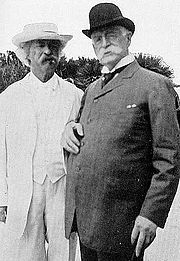
The two men introduced each other to their acquaintances. Twain was an admirer of the remarkable deafblind girl Helen Keller. He first met Keller and her teacher Anne Sullivan at a party in the home of Laurence Hutton in New York City in the winter of 1894. Twain introduced them to Rogers, who, with his wife, paid for Keller's education at Radcliffe College. It was Twain who is credited with labeling Sullivan, Keller's governess and companion, a "miracle worker." His choice of words later became inspiration for the title of William Gibson's play and film adaptation, The Miracle Worker. Twain also introduced Rogers to journalist Ida M. Tarbell, who interviewed the robber baron for a muckraking expose that led indirectly to the break-up of the Standard Oil Trust. On cruises aboard the Kanawha, Twain and Rogers were joined at frequent intervals by Booker T. Washington, the famed former slave who had become a leading educator.
While the two famous old men were widely regarded as drinking and poker buddies, they also exchanged letters when apart, and this was often since each traveled a great deal. Unlike Rogers' personal files, which have never become public, these insightful letters were published. The written exchanges between the two men demonstrate Twain's well-known sense of humor and, more surprisingly, Rogers' sense of fun, providing a rare insight into the private side of the robber baron.
In April 1907, Twain and Rogers cruised to the opening of the Jamestown Exposition in Virginia. Twain's public popularity was such that many fans took boats out to the Kanawha at anchor in hopes of getting a glimpse of him. As the gathering of boats around the yacht became a safety hazard, he finally obliged by coming on deck and waving to the crowds.
Because of poor weather conditions, the steam yacht was delayed for several days from venturing into the Atlantic Ocean. Rogers and some of the others in his party returned to New York by rail; Twain disliked train travel and so elected to wait and return on the Kanawha. However, reporters lost track of his whereabouts; when he failed to return to New York City as scheduled, The New York Times speculated that he might have been "lost at sea." Upon arriving safely in New York and learning of this, the humorist wrote a satirical article about the episode, offering to "...make an exhaustive investigation of this report that I have been lost at sea. If there is any foundation for the report, I will at once apprise the anxious public." This bore similarities to an earlier event in 1897 when he made his famous remark "The report of my death is an exaggeration", after a reporter was sent to investigate whether he had died. (In fact, it was his cousin who was seriously ill.) See List of premature obituaries.
Later that year, Twain and Rogers's son, Henry Jr., returned to the Jamestown Exposition aboard the Kanawha. The humorist helped host Robert Fulton Day on September 23 1907, celebrating the centennial of Fulton's invention of the steamboat. Twain, filling in for ailing former U.S. President Grover Cleveland, introduced Rear Admiral Purnell Harrington. Twain was met with a five-minute standing ovation; members of the audience cheered and waved their hats and umbrellas. Deeply touched, Twain said, "When you appeal to my head, I don't feel it; but when you appeal to my heart, I do feel it."
In April 1909 the two old friends returned to Norfolk, Virginia for the banquet in honour of Rogers and his newly completed Virginian Railway. Twain was the keynote speaker in one of his last public appearances, and was widely quoted in newspapers across the country.
A month later, Twain was en route from Connecticut to visit his friend in New York City when Rogers died suddenly on May 20 1909. Twain arrived at Grand Central Station to be met by his daughter with the news. Stricken with grief, he uncustomarily avoided news reporters who had gathered, saying only "This is terrible...I cannot talk about it." Two days later, he served as an honorary pallbearer at the funeral in New York City. However, he declined to join the funeral party on the train ride for the interment at Fairhaven. He said "I cannot bear to travel with my friend and not converse."
Legacy
Twain's legacy lives on today as his namesakes continue to multiply. Several schools are named after him, including Twain Elementary School in Houston, Texas, which has a statue of Twain sitting on a bench, and Mark Twain Intermediate School in New York. There are several schools named Mark Twain Middle School in different states, as well as Samuel Clemens High School in Schertz, near San Antonio, Texas. There are also other structures, such as the Mark Twain Memorial Bridge.
Awards in his name proliferate. In 1998, The John F. Kennedy Centre for the Performing Arts created the Mark Twain Prize for American Humor, awarded annually. The Mark Twain Award is an award given annually to a book for children in grades four through eight by the Missouri Association of School Librarians. Stetson University in DeLand, Florida sponsors the Mark Twain Young Authors' Workshop each summer in collaboration with the Boyhood Home and Museum in Hannibal. The program is open to young authors in grades five through eight. The museum sponsors the Mark Twain Creative Teaching Award.
Buildings associated with Twain, including some of his many homes, have been preserved as museums. His birthplace is preserved in Florida, Missouri. The Mark Twain Boyhood Home and Museum in Hannibal, Missouri preserves the setting for some of the author's best-known work. The home of childhood friend Laura Hawkins, said to be the inspiration for his fictional character Becky Thatcher, is preserved as the "Thatcher House." In May 2007, a painstaking reconstruction of the home of Tom Blankenship, the inspiration for Huckleberry Finn, was opened to the public. The family home he had built in Hartford, Connecticut, where he and his wife raised their three daughters, is preserved and open to visitors as the Mark Twain House.
Actor Hal Holbrook created a one-man show called Mark Twain Tonight, which he has performed regularly for 50 years. The broadcast by CBS in 1967 won him an Emmy Award. Of the three runs on Broadway (1966, 1977, and 2005), the first won him a Tony Award.
Additionally, like countless influential individuals, Twain was honored by having an asteroid, 2362 Mark Twain, named after him.
Often, Twain is depicted on pop culture as wearing an all-white suit. While there is evidence that suggests that, after Livy's death in 1904, Twain began wearing white suits on the lecture circuit, modern representations suggesting that he wore them throughout his life was unfounded. There is no evidence of him wearing a white suit before 1904; however, it did eventually become his trademark, and anecdotes about this eccentricity (such as the time he wore a white summer-suit to a Congressional hearing during the winter).
Pen names
Twain used different pen names (pseudonyms or "noms de plume") before deciding on "Mark Twain". He signed humorous and imaginative sketches "Josh" until 1863. Additionally, he used the pen name "Thomas Jefferson Snodgrass" for a series of humorous letters.
He maintained that his primary pen name came from his years working on Mississippi riverboats, where two fathoms, a depth indicating "safe water" for the boat to float over, was measured on the sounding line. A fathom is a maritime unit of depth, equivalent to two yards (1.8 m); "twain" is an archaic term for "two". The riverboatman's cry was "mark twain" or, more fully, "by the mark twain", meaning "according to the mark [on the line], [the depth is] two [fathoms]", that is, "there are 12 feet (3.7 m) of water under the boat and it is safe to pass".
Twain claimed that his famous pen name was not entirely his invention. In Life on the Mississippi, he wrote:
Captain Isaiah Sellers was not of literary turn or capacity, but he used to jot down brief paragraphs of plain practical information about the river, and sign them "MARK TWAIN," and give them to the New Orleans Picayune. They related to the stage and condition of the river, and were accurate and valuable; ... At the time that the telegraph brought the news of his death, I was on the Pacific coast. I was a fresh new journalist, and needed a nom de guerre; so I confiscated the ancient mariner's discarded one, and have done my best to make it remain what it was in his hands—a sign and symbol and warrant that whatever is found in its company may be gambled on as being the petrified truth; how I have succeeded, it would not be modest in me to say.
Twain's version of the story regarding his nom de plume is not without detractors and has been called into question by biographer George Williams III, the Territorial Enterprise newspaper and Purdue University's Paul Fatout. These sources claim that "mark twain" refers to a running bar tab that Twain would regularly incur while drinking at John Piper's saloon in Virginia City, Nevada.
